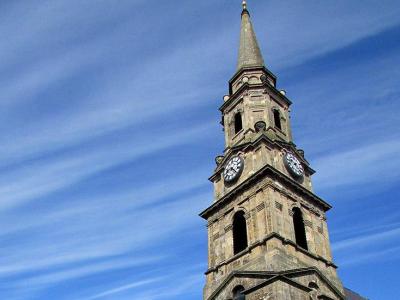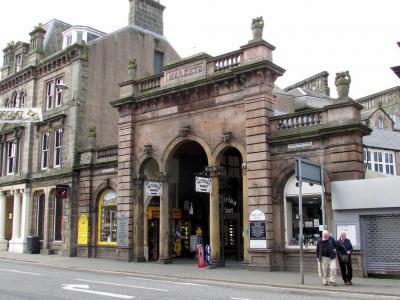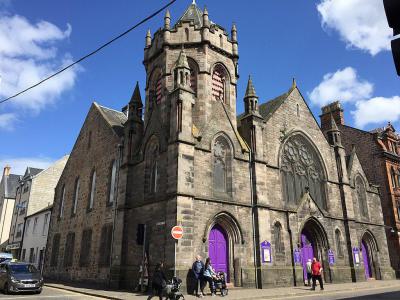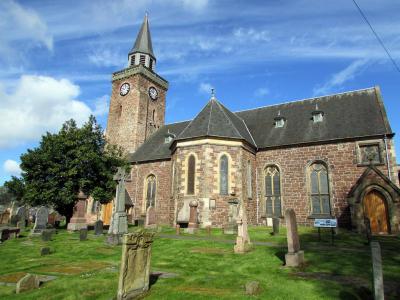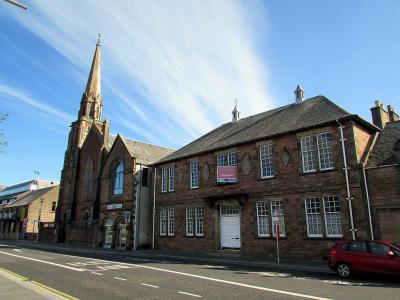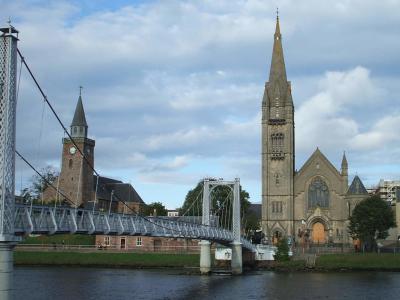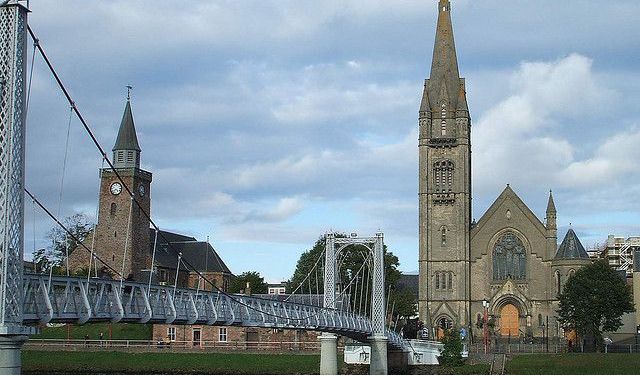
Inverness Historical Buildings Walking Tour (Self Guided), Inverness
Inverness, a city established in the 12th century, boasts an array of historical architecture reflecting its rich and often tumultuous past. Many of its centuries-old buildings are situated along the banks of the River Ness and blend effortlessly with the surrounding landscape.
Undoubtedly, prime among these is the Inverness Castle, perched majestically atop a hill overlooking the city. Originally built in the 11th century, this castle has undergone numerous renovations over the years and is now a prominent landmark.
Another iconic structure, the Tollbooth Steeple, is a striking testament to Inverness's civic pride. This elegant edifice once served as a courthouse and town hall, embodying the city's administrative heritage.
Adjacent to it stands the Inverness Town House, a grand building with a storied past. Built in the late 19th century, it remains an architectural gem, hosting various civic functions and events.
Further into the city center, the Victorian Market, a bustling hub of activity, offers a glimpse into Inverness's commercial history. Its ornate façade and bustling interior provide a nostalgic experience for visitors.
Religious landmarks also dot the cityscape, including the Inverness East Church and the Old High Church, both cherished symbols of faith and community.
Dunbar's Hospital and Abertarff House add another layer to Inverness's architectural tapestry, showcasing the city's commitment to preserving its heritage.
Saint Columba High Church, Free North Church, and Saint Mary's Roman Catholic Church serve as spiritual anchors, each with its unique character and significance.
Finally, the imposing Inverness Cathedral, notable for its most northerly change-ringing bells, stands as a testament to the enduring presence of Christianity in the city.
Inverness's historical buildings – vivid reminders of the past – are also vibrant spaces for the present community to cherish and enjoy. Our self-guided tour will help you visit these prominent landmarks, delve into their stories, and thus become part, if only for a brief moment, of Inverness's living history.
Undoubtedly, prime among these is the Inverness Castle, perched majestically atop a hill overlooking the city. Originally built in the 11th century, this castle has undergone numerous renovations over the years and is now a prominent landmark.
Another iconic structure, the Tollbooth Steeple, is a striking testament to Inverness's civic pride. This elegant edifice once served as a courthouse and town hall, embodying the city's administrative heritage.
Adjacent to it stands the Inverness Town House, a grand building with a storied past. Built in the late 19th century, it remains an architectural gem, hosting various civic functions and events.
Further into the city center, the Victorian Market, a bustling hub of activity, offers a glimpse into Inverness's commercial history. Its ornate façade and bustling interior provide a nostalgic experience for visitors.
Religious landmarks also dot the cityscape, including the Inverness East Church and the Old High Church, both cherished symbols of faith and community.
Dunbar's Hospital and Abertarff House add another layer to Inverness's architectural tapestry, showcasing the city's commitment to preserving its heritage.
Saint Columba High Church, Free North Church, and Saint Mary's Roman Catholic Church serve as spiritual anchors, each with its unique character and significance.
Finally, the imposing Inverness Cathedral, notable for its most northerly change-ringing bells, stands as a testament to the enduring presence of Christianity in the city.
Inverness's historical buildings – vivid reminders of the past – are also vibrant spaces for the present community to cherish and enjoy. Our self-guided tour will help you visit these prominent landmarks, delve into their stories, and thus become part, if only for a brief moment, of Inverness's living history.
How it works: Download the app "GPSmyCity: Walks in 1K+ Cities" from Apple App Store or Google Play Store to your mobile phone or tablet. The app turns your mobile device into a personal tour guide and its built-in GPS navigation functions guide you from one tour stop to next. The app works offline, so no data plan is needed when traveling abroad.
Inverness Historical Buildings Walking Tour Map
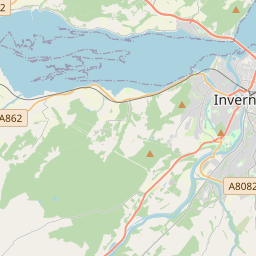





Guide Name: Inverness Historical Buildings Walking Tour
Guide Location: Scotland » Inverness (See other walking tours in Inverness)
Guide Type: Self-guided Walking Tour (Sightseeing)
# of Attractions: 13
Tour Duration: 2 Hour(s)
Travel Distance: 2.0 Km or 1.2 Miles
Author: leticia
Sight(s) Featured in This Guide:
Guide Location: Scotland » Inverness (See other walking tours in Inverness)
Guide Type: Self-guided Walking Tour (Sightseeing)
# of Attractions: 13
Tour Duration: 2 Hour(s)
Travel Distance: 2.0 Km or 1.2 Miles
Author: leticia
Sight(s) Featured in This Guide:
- Inverness Castle
- Tollbooth Steeple
- Inverness Town House
- Victorian Market
- Inverness East Church
- Old High Church
- Dunbar's Hospital
- Abertarff House
- St. Columba High Church
- Free North Church
- Balnain House
- St. Mary's Roman Catholic Church
- Inverness Cathedral
1) Inverness Castle (must see)
Perched on a cliff overlooking the River Ness, Inverness Castle has stood as a sentinel of Scottish history since 1057, though its current red sandstone structure dates to 1836. A Category A listed building, the castle has witnessed centuries of rebellion, royal intrigue, and architectural transformation.
The site's first castle is believed to have been constructed by Malcolm III of Scotland and later fortified by Shaw Macduff, the first chief of Clan Mackintosh, under Malcolm IV in 1163. The original fortress endured dramatic events, including partial destruction by Robert the Bruce in 1307 and the fiery retaliation by Lord Alexander, 3rd Lord of the Isles, in 1428 after being imprisoned there by James I.
The modern castle, a striking example of early castellated architecture, was designed by William Burn and completed in 1836. Featuring a symmetrical main façade and castellated towers, its southern block once housed the County Buildings and Sheriff Court. The northern block, added in 1848 by Thomas Brown II, served as a prison and courthouse. Surrounding bastioned walls were designed by Joseph Mitchell, completing the fortress-like aesthetic.
Over the centuries, the castle became a repository of military history, displaying captured field guns from battles such as the Battle of Loos and the Crimean War. Today, only the gun from Loos remains, preserved at the Clan Cameron Museum.
Inverness Castle transitioned from a seat of county governance to a judicial hub before the relocation of court functions in 2020. Closed for extensive renovations in 2021, the castle is slated to reopen in 2025, promising a renewed space for public engagement with its storied past.
The site's first castle is believed to have been constructed by Malcolm III of Scotland and later fortified by Shaw Macduff, the first chief of Clan Mackintosh, under Malcolm IV in 1163. The original fortress endured dramatic events, including partial destruction by Robert the Bruce in 1307 and the fiery retaliation by Lord Alexander, 3rd Lord of the Isles, in 1428 after being imprisoned there by James I.
The modern castle, a striking example of early castellated architecture, was designed by William Burn and completed in 1836. Featuring a symmetrical main façade and castellated towers, its southern block once housed the County Buildings and Sheriff Court. The northern block, added in 1848 by Thomas Brown II, served as a prison and courthouse. Surrounding bastioned walls were designed by Joseph Mitchell, completing the fortress-like aesthetic.
Over the centuries, the castle became a repository of military history, displaying captured field guns from battles such as the Battle of Loos and the Crimean War. Today, only the gun from Loos remains, preserved at the Clan Cameron Museum.
Inverness Castle transitioned from a seat of county governance to a judicial hub before the relocation of court functions in 2020. Closed for extensive renovations in 2021, the castle is slated to reopen in 2025, promising a renewed space for public engagement with its storied past.
2) Tollbooth Steeple
The Tollbooth Steeple in Inverness is a Georgian landmark rich in history and architectural charm. Completed in 1791, the 45-meter (130-foot) tower was originally part of the Inverness Tolbooth, which housed a courthouse, prison cells, and city council offices. Designed by Alexander Laing in the neoclassical style, the steeple is the last remaining part of this historic complex, which became redundant after new facilities were built at Inverness Castle in the 19th century.
The steeple's seven-stage design features round-headed openings, a Venetian window, an octagonal belfry, and a spire topped with a weather vane. A clock crafted by James Bridges of Glasgow graces the tower, with its chimes marking the quarters and hours from 8:00 a.m. to 8:00 p.m. daily. This clock was electrified in 1979, modernizing its historic mechanism.
Notable trials during the Highland Clearances took place within the original Tolbooth courtroom, including the 1792 Strathrusdale protest and the infamous 1814 trial of Patrick Sellar. These events have left their mark on the steeple’s legacy, with a commemorative plaque recalling the struggles of tenant farmers.
The steeple underwent significant restorations after an 1816 earth tremor and again in 2013 to preserve its heritage. Today, the lower levels house a business selling historical and heraldic gifts, blending its storied past with modern use. Recognized as a Category A listed building, the Tollbooth Steeple is a symbol of Inverness’s historical and architectural heritage.
The steeple's seven-stage design features round-headed openings, a Venetian window, an octagonal belfry, and a spire topped with a weather vane. A clock crafted by James Bridges of Glasgow graces the tower, with its chimes marking the quarters and hours from 8:00 a.m. to 8:00 p.m. daily. This clock was electrified in 1979, modernizing its historic mechanism.
Notable trials during the Highland Clearances took place within the original Tolbooth courtroom, including the 1792 Strathrusdale protest and the infamous 1814 trial of Patrick Sellar. These events have left their mark on the steeple’s legacy, with a commemorative plaque recalling the struggles of tenant farmers.
The steeple underwent significant restorations after an 1816 earth tremor and again in 2013 to preserve its heritage. Today, the lower levels house a business selling historical and heraldic gifts, blending its storied past with modern use. Recognized as a Category A listed building, the Tollbooth Steeple is a symbol of Inverness’s historical and architectural heritage.
3) Inverness Town House
Inverness Town House is a municipal building located on High Street between Castle Street and Castle Wynd. The Gothic-style building was designed by architect William Lawrie in 1882. The house was built to replace the very first town house in Inverness, which was built in 1708 and demolished 150 years later.
The house was modeled on the McManus, a museum and art gallery that was designed by George Gilbert Scott. A burgh coat of arms, recovered from a bridge that crossed the River Ness, is embedded in the ashlar stone from which the townhouse is comprised. That coat of arms dates to 1685 when the bridge was completed.
An update on the town house took place in 1898 when William Meikle & Sons installed stained glass windows to celebrate Queen Victoria's Diamond Jubilee. The building was also extended in 1907. It did not undergo a major refurbishment again until 2018.
The Inverness Town House is known for containing a large number of works of art. Those who wish to see the inside of the town house should try to schedule a tour in advance. These tours take place on Thursdays at 2 PM and 3:30 PM.
The house was modeled on the McManus, a museum and art gallery that was designed by George Gilbert Scott. A burgh coat of arms, recovered from a bridge that crossed the River Ness, is embedded in the ashlar stone from which the townhouse is comprised. That coat of arms dates to 1685 when the bridge was completed.
An update on the town house took place in 1898 when William Meikle & Sons installed stained glass windows to celebrate Queen Victoria's Diamond Jubilee. The building was also extended in 1907. It did not undergo a major refurbishment again until 2018.
The Inverness Town House is known for containing a large number of works of art. Those who wish to see the inside of the town house should try to schedule a tour in advance. These tours take place on Thursdays at 2 PM and 3:30 PM.
4) Victorian Market
The Victorian Market, nestled in the heart of Inverness, is a charming covered market that blends history, architecture, and local enterprise. This historic market, originally constructed in 1870 and rebuilt after a fire in 1890, boasts a striking Victorian-style building with ornate features like glass, timber, and cast-iron roof, as well as round-headed shopfronts. The surviving Academy Street entrance, scarred with knife marks from fish merchants of old, adds a unique historical touch.
Within the market, three distinct areas—Market Hall, Market Arcade, and Queensgate Arcade—host over 30 independent businesses. These shops, cafés, and services, many of which have been trading for generations, offer a wide range of high-quality goods. From clothing and accessories to gifts and souvenirs, visitors can discover unique products while experiencing a warm Highland welcome. The refurbished Market Hall provides a vibrant social hub, featuring a central seating area surrounded by stalls showcasing the best of Highland food producers. It’s an ideal spot for families and groups to enjoy local delicacies.
A must-visit destination, the Victorian Market captures the essence of Inverness with its blend of history, community spirit, and modern-day shopping. Whether you're hunting for treasures, indulging in refreshments, or simply soaking up the atmosphere, this iconic market is sure to leave a lasting impression.
Within the market, three distinct areas—Market Hall, Market Arcade, and Queensgate Arcade—host over 30 independent businesses. These shops, cafés, and services, many of which have been trading for generations, offer a wide range of high-quality goods. From clothing and accessories to gifts and souvenirs, visitors can discover unique products while experiencing a warm Highland welcome. The refurbished Market Hall provides a vibrant social hub, featuring a central seating area surrounded by stalls showcasing the best of Highland food producers. It’s an ideal spot for families and groups to enjoy local delicacies.
A must-visit destination, the Victorian Market captures the essence of Inverness with its blend of history, community spirit, and modern-day shopping. Whether you're hunting for treasures, indulging in refreshments, or simply soaking up the atmosphere, this iconic market is sure to leave a lasting impression.
5) Inverness East Church
Inverness East Church, a Category B listed building, is a landmark steeped in rich history and architectural evolution. Originally opened in 1798 as a chapel of ease for the Church of Scotland, the building underwent significant transformations over the centuries. Rebuilt in 1852–1853 and enhanced with a distinctive street frontage in 1897–1898 by the architectural firm Ross & Macbeth, the structure became a symbol of resilience and community adaptability.
The church's journey reflects pivotal moments in Scottish ecclesiastical history. During the disruption of 1843, it left the Church of Scotland, becoming Inverness East Free Church. In 1900, it joined the United Presbyterian Church of Scotland to form the United Free Church of Scotland, only to return to the Church of Scotland in 1929 alongside many other United Free churches. Throughout these transitions, the church served a parish that included the city center of Inverness and the surrounding areas of Longman, Drakies, and Raigmore.
In addition to its role as a place of worship, Inverness East Church made a tangible impact through its outreach initiatives. Notably, "The Shack," a former rent office on the Raigmore estate, became a vital hub for community support. It provided a drop-in space for those in need and served as the base for various congregation-led activities, underscoring the church's commitment to social welfare.
In 2022, the Inverness Presbytery announced plans to merge the parish with Inshes Church and close East Church. After 225 years of service, the final worship service was held on March 5, 2023. Dr. A. T. B. McGowan, the church's last minister, retired in 2019, marking the end of an era.
The building's story took an exciting turn in 2024 when it was purchased by Cultarlann Inbhir Nis, a charity dedicated to promoting Gaelic culture. Plans are underway to transform the historic site into a vibrant Gaelic cultural center, ensuring that the legacy of Inverness East Church continues in a new and meaningful way.
The church's journey reflects pivotal moments in Scottish ecclesiastical history. During the disruption of 1843, it left the Church of Scotland, becoming Inverness East Free Church. In 1900, it joined the United Presbyterian Church of Scotland to form the United Free Church of Scotland, only to return to the Church of Scotland in 1929 alongside many other United Free churches. Throughout these transitions, the church served a parish that included the city center of Inverness and the surrounding areas of Longman, Drakies, and Raigmore.
In addition to its role as a place of worship, Inverness East Church made a tangible impact through its outreach initiatives. Notably, "The Shack," a former rent office on the Raigmore estate, became a vital hub for community support. It provided a drop-in space for those in need and served as the base for various congregation-led activities, underscoring the church's commitment to social welfare.
In 2022, the Inverness Presbytery announced plans to merge the parish with Inshes Church and close East Church. After 225 years of service, the final worship service was held on March 5, 2023. Dr. A. T. B. McGowan, the church's last minister, retired in 2019, marking the end of an era.
The building's story took an exciting turn in 2024 when it was purchased by Cultarlann Inbhir Nis, a charity dedicated to promoting Gaelic culture. Plans are underway to transform the historic site into a vibrant Gaelic cultural center, ensuring that the legacy of Inverness East Church continues in a new and meaningful way.
6) Old High Church
The Old High Church, located in Inverness, is a historic parish church of the Church of Scotland, situated along the picturesque banks of the River Ness. Part of Old High Saint Stephen's Parish, the church holds the distinction of being the oldest congregation in Inverness, with roots tracing back to Celtic times. Tradition links its founding to Saint Columba, the Irish monk credited with bringing Christianity to the region.
While the current church building dates primarily to the 18th century, its site has been a place of worship for centuries, making it the historic town church of Inverness. Among its notable features is a Father Willis organ, restored in 2010, which adds to its architectural and cultural significance. The Old High Church is a Category A listed building, underscoring its importance in Scotland's heritage.
The Old High congregation united with that of Saint Stephen’s Church in October 2003 to form Old High Saint Stephen’s Parish. In a rare arrangement, both buildings were retained for worship. However, regular services at the Old High Church ceased in January 2022, with Sunday worship now held exclusively at Saint Stephen’s Church at 10:30 AM.
Saint Stephen’s, established as a 'daughter church' of the Old High in 1897, is a Gothic-style building constructed from Morayshire freestone, designed by architect W.L. Carruthers. It holds a Category B listing, reflecting its architectural merit.
The Old High Church is a significant part of Inverness’s ecclesiastical and cultural history. Its parish area encompasses the city center, parts of the Crown area, and southern suburbs like Drummond and Lochardil.
While the current church building dates primarily to the 18th century, its site has been a place of worship for centuries, making it the historic town church of Inverness. Among its notable features is a Father Willis organ, restored in 2010, which adds to its architectural and cultural significance. The Old High Church is a Category A listed building, underscoring its importance in Scotland's heritage.
The Old High congregation united with that of Saint Stephen’s Church in October 2003 to form Old High Saint Stephen’s Parish. In a rare arrangement, both buildings were retained for worship. However, regular services at the Old High Church ceased in January 2022, with Sunday worship now held exclusively at Saint Stephen’s Church at 10:30 AM.
Saint Stephen’s, established as a 'daughter church' of the Old High in 1897, is a Gothic-style building constructed from Morayshire freestone, designed by architect W.L. Carruthers. It holds a Category B listing, reflecting its architectural merit.
The Old High Church is a significant part of Inverness’s ecclesiastical and cultural history. Its parish area encompasses the city center, parts of the Crown area, and southern suburbs like Drummond and Lochardil.
7) Dunbar's Hospital
Dunbar's Hospital was built in 1668 as a hospital and a home for the impoverished. The hospital has a rough-cast, harled finish and dormer windows surrounded by decorative brickwork. The arched doorway offers the same brickwork and a protective iron gate.
Above the door is a plaque that shows the coat of arms of Provost Alexander Dunbar, founder of the hospital. This plaque, with a date of 1676, is a reproduction of the original. Those who wish to see the original plate can find it at the Inverness Museum.
Dunbar's Hospital was used as a school until the Royal Academy opened in 1792. It was also, at times, divided into apartments, used for shops and as a senior citizen's center. It briefly returned to use as a hospital during the 1849 Cholera Epidemic. Today, the hospital is divided into a senior citizen's day center and a restaurant that is open on weekends from 9 AM to 4 PM.
The hospital is rumored to have been built from stone that was discarded from Oliver Cromwell's destroyed citadel.
Above the door is a plaque that shows the coat of arms of Provost Alexander Dunbar, founder of the hospital. This plaque, with a date of 1676, is a reproduction of the original. Those who wish to see the original plate can find it at the Inverness Museum.
Dunbar's Hospital was used as a school until the Royal Academy opened in 1792. It was also, at times, divided into apartments, used for shops and as a senior citizen's center. It briefly returned to use as a hospital during the 1849 Cholera Epidemic. Today, the hospital is divided into a senior citizen's day center and a restaurant that is open on weekends from 9 AM to 4 PM.
The hospital is rumored to have been built from stone that was discarded from Oliver Cromwell's destroyed citadel.
8) Abertarff House
Abertarff House, built in 1593, holds the distinction of being the oldest residential house in Inverness. Nestled on Church Street (formerly the Kirkgate), this 2½-storey townhouse showcases traditional 16th- and early 17th-century Scottish architecture, complete with crow-stepped gables and a prominent projecting turnpike staircase.
Briefly owned by the Fraser of Lovat family—renowned for their Jacobite connection during the Battle of Culloden—the house transitioned to various owners over the centuries. In the 19th century, it was acquired by the Commercial Bank of Scotland but later fell into disrepair after being divided for housing. Abertarff House found new life when it was gifted to the National Trust for Scotland in 1963 and subsequently restored in 1966.
Over its storied history, the house has served multiple purposes, including as the headquarters of the Gaelic Association (An Comunn Gàidhealach), a shop, and the regional office for the Trust. Today, Abertarff House welcomes visitors with two open downstairs rooms, offering insights into 17th-century life in Inverness. Plans are underway to open additional exhibition spaces upstairs in 2024.
Knowledgeable staff are on hand to share the building's rich history, recount life in the 1600s, and guide visitors to other notable sites in the Highlands, including Culloden Battlefield, Hugh Miller’s Cottage, and Brodie Castle.
Lovingly cared for by the National Trust for Scotland, Abertarff House is a remarkable reminder of Inverness's architectural and cultural heritage.
Briefly owned by the Fraser of Lovat family—renowned for their Jacobite connection during the Battle of Culloden—the house transitioned to various owners over the centuries. In the 19th century, it was acquired by the Commercial Bank of Scotland but later fell into disrepair after being divided for housing. Abertarff House found new life when it was gifted to the National Trust for Scotland in 1963 and subsequently restored in 1966.
Over its storied history, the house has served multiple purposes, including as the headquarters of the Gaelic Association (An Comunn Gàidhealach), a shop, and the regional office for the Trust. Today, Abertarff House welcomes visitors with two open downstairs rooms, offering insights into 17th-century life in Inverness. Plans are underway to open additional exhibition spaces upstairs in 2024.
Knowledgeable staff are on hand to share the building's rich history, recount life in the 1600s, and guide visitors to other notable sites in the Highlands, including Culloden Battlefield, Hugh Miller’s Cottage, and Brodie Castle.
Lovingly cared for by the National Trust for Scotland, Abertarff House is a remarkable reminder of Inverness's architectural and cultural heritage.
9) St. Columba High Church
Saint Columba High Church, situated on Bank Street in Inverness, is a prominent example of Perpendicular Gothic architecture and an enduring symbol of the city’s rich historical and spiritual heritage. Dedicated to Saint Columba, this church was constructed between 1851 and 1852 by architects MacKenzie and Matthews on the site of an old brewery. Initially built as the Free High Church, it is now a Category B-listed building, recognized for its architectural and historical significance.
The church faced significant challenges when a fire in 1939 caused extensive damage. However, between 1948 and 1953, it was meticulously restored to its current state, preserving its Gothic Revival style, with its stone façade, arched windows, and intricate masonry details. Positioned on the corner of Bank Street and Fraser Street, the building remains a striking landmark overlooking the River Ness.
For many years, Saint Columba High Church served as a parish church of the Church of Scotland. Recently, its congregation relocated, and the building was acquired by CityLife Church, which is undertaking renovations to adapt the space for contemporary worship and community activities.
With its storied past, architectural grandeur, and riverside setting, Saint Columba High Church continues to be an integral part of Inverness’s cultural and spiritual fabric. Its restoration and new purpose ensure that it remains a cherished landmark in the city's heart.
The church faced significant challenges when a fire in 1939 caused extensive damage. However, between 1948 and 1953, it was meticulously restored to its current state, preserving its Gothic Revival style, with its stone façade, arched windows, and intricate masonry details. Positioned on the corner of Bank Street and Fraser Street, the building remains a striking landmark overlooking the River Ness.
For many years, Saint Columba High Church served as a parish church of the Church of Scotland. Recently, its congregation relocated, and the building was acquired by CityLife Church, which is undertaking renovations to adapt the space for contemporary worship and community activities.
With its storied past, architectural grandeur, and riverside setting, Saint Columba High Church continues to be an integral part of Inverness’s cultural and spiritual fabric. Its restoration and new purpose ensure that it remains a cherished landmark in the city's heart.
10) Free North Church
The Free North Church is a historic, Protestant church in Inverness. It rests on Bank Street at the northeast bank of the River Ness. The Free North Church is located near a number of other tourist destinations in the city. Some of these include the Grieg Street Bridge, Inverness Castle and the Egypt War Memorial.
The Gothic-style church was completed in 1893 from a design by architect Alexander Ross. The grand-size of the church allows for a congregation of up to 1,300. The church offers a tower, stair-tower, gable and porch. Its octagonal spire, which reaches 170 feet, is the tallest in the city.
Visitors can explore the grounds of the Free North Church, including the historic cemetery. Those wanting to join the church during worship are welcome to be part of the congregation during the 11 AM or 5:30 PM services on Sundays.
The Gothic-style church was completed in 1893 from a design by architect Alexander Ross. The grand-size of the church allows for a congregation of up to 1,300. The church offers a tower, stair-tower, gable and porch. Its octagonal spire, which reaches 170 feet, is the tallest in the city.
Visitors can explore the grounds of the Free North Church, including the historic cemetery. Those wanting to join the church during worship are welcome to be part of the congregation during the 11 AM or 5:30 PM services on Sundays.
11) Balnain House
Balnain House, a striking Georgian-style building on Huntly Street in the heart of Inverness, is a rare and well-preserved example of 18th-century architecture. Constructed in 1726, it features a distinctive regular-fronted design, offering a glimpse into Scotland’s architectural heritage. Initially built as a townhouse for the Duffs of Drummuir, Balnain House has served many roles over the centuries, reflecting the dynamic history of the Highlands.
One of its most notable chapters came in 1746, following the Battle of Culloden when the house was repurposed as a hospital for wounded government troops. Today, the building houses the offices of the National Trust for Scotland, safeguarding its legacy while serving a practical purpose.
Balnain House holds a special place in popular culture as an Outlander location, referenced in both the beloved book series and the television adaptation. Although the building is not open to the public regularly, visitors can admire its exterior and read about its storied past on informational plaques. Occasionally, during Doors Open Days, the interior is accessible, offering a rare chance to explore this historic gem.
Situated along the picturesque River Ness, Balnain House is a fascinating stop for history enthusiasts and fans of Outlander alike, connecting visitors to the rich tapestry of Inverness's past.
One of its most notable chapters came in 1746, following the Battle of Culloden when the house was repurposed as a hospital for wounded government troops. Today, the building houses the offices of the National Trust for Scotland, safeguarding its legacy while serving a practical purpose.
Balnain House holds a special place in popular culture as an Outlander location, referenced in both the beloved book series and the television adaptation. Although the building is not open to the public regularly, visitors can admire its exterior and read about its storied past on informational plaques. Occasionally, during Doors Open Days, the interior is accessible, offering a rare chance to explore this historic gem.
Situated along the picturesque River Ness, Balnain House is a fascinating stop for history enthusiasts and fans of Outlander alike, connecting visitors to the rich tapestry of Inverness's past.
12) St. Mary's Roman Catholic Church
Saint Mary’s Roman Catholic Church is a historic and spiritual gem in Inverness. Located on the west bank of the River Ness, just a stone’s throw from the city center, this remarkable church is celebrated as the first Catholic place of worship built in Inverness after the Reformation, opening its doors on April 2, 1837. Designed in the Gothic Revival style by William Robertson, the church has undergone several enhancements over the centuries, each adding to its architectural and cultural significance.
The church is renowned for its exquisite altar and breathtaking stained glass windows, which have been enhanced over time. Notably, a significant reordering of the sanctuary was completed in 2014 to align with liturgical changes following the Second Vatican Council. This included the installation of a new altar, a reliquary, and intricate tiled flooring. A millennium-stained glass window, an icon of the Presentation of the Child, and a statue commemorating the 400th anniversary of Saint John Ogilvie’s martyrdom in 2015 further enrich its interior, creating an inspiring and serene atmosphere.
In its early years, the church served a modest Catholic community that had been worshiping in Margaret Street since the mission separated from Eskdale in 1827. By 1846, approximately 400 Catholics called Inverness home. Thanks to the generosity of benefactors such as Miss Jessie McDonell, the presbytery was added in 1888, and in 1894, a solemn re-opening marked the remodeling of the sanctuary, complete with a new altar by Peter Paul Pugin and Stations of the Cross.
Saint Mary’s continues to play a vital role in the spiritual life of Inverness, hosting daily Mass and serving as the Polish-language Chaplaincy for the city. Its doors are open to visitors seeking a quiet moment of reflection or those eager to explore its historical and artistic legacy.
The church is renowned for its exquisite altar and breathtaking stained glass windows, which have been enhanced over time. Notably, a significant reordering of the sanctuary was completed in 2014 to align with liturgical changes following the Second Vatican Council. This included the installation of a new altar, a reliquary, and intricate tiled flooring. A millennium-stained glass window, an icon of the Presentation of the Child, and a statue commemorating the 400th anniversary of Saint John Ogilvie’s martyrdom in 2015 further enrich its interior, creating an inspiring and serene atmosphere.
In its early years, the church served a modest Catholic community that had been worshiping in Margaret Street since the mission separated from Eskdale in 1827. By 1846, approximately 400 Catholics called Inverness home. Thanks to the generosity of benefactors such as Miss Jessie McDonell, the presbytery was added in 1888, and in 1894, a solemn re-opening marked the remodeling of the sanctuary, complete with a new altar by Peter Paul Pugin and Stations of the Cross.
Saint Mary’s continues to play a vital role in the spiritual life of Inverness, hosting daily Mass and serving as the Polish-language Chaplaincy for the city. Its doors are open to visitors seeking a quiet moment of reflection or those eager to explore its historical and artistic legacy.
13) Inverness Cathedral (must see)
Inverness Cathedral is a Scottish Episcopal Church on the banks of the River Ness. The cathedral, also known as the Cathedral Church of Saint Andrew, is the seat of of the Bishop of Moray, Ross and Caithness. It was the first new Protestant cathedral built in Britain after the Reformation.
Inverness Cathedral was built in 1869 from a design by architect Alexander Ross. The cathedral is made from red tarradale stone and peterhead granite. The cathedral is noted for having the most northerly change-ringing church bells in the world.
The cathedral welcomes visitors throughout the year. The church doors are open from 10 AM to 4 PM daily. Likewise, the cathedral's gift shop and cafe are open every day except Christmas. A cathedral supervisor is on-hand to help with any questions.
Along with church services, Inverness Cathedral regularly hosts live music events, morning coffee and special events. Tourists are welcome to attend church services and any of the special events as they please.
Inverness Cathedral was built in 1869 from a design by architect Alexander Ross. The cathedral is made from red tarradale stone and peterhead granite. The cathedral is noted for having the most northerly change-ringing church bells in the world.
The cathedral welcomes visitors throughout the year. The church doors are open from 10 AM to 4 PM daily. Likewise, the cathedral's gift shop and cafe are open every day except Christmas. A cathedral supervisor is on-hand to help with any questions.
Along with church services, Inverness Cathedral regularly hosts live music events, morning coffee and special events. Tourists are welcome to attend church services and any of the special events as they please.
Walking Tours in Inverness, Scotland
Create Your Own Walk in Inverness
Creating your own self-guided walk in Inverness is easy and fun. Choose the city attractions that you want to see and a walk route map will be created just for you. You can even set your hotel as the start point of the walk.
Inverness Introduction Walking Tour
Often regarded as the Capital of the Scottish Highlands, Inverness is steeped in history and legend. The name "Inverness" derives from the Scottish Gaelic "Inbhir Nis," which means "mouth of the River Ness," a fitting moniker for a city that thrives along the banks of this scenic waterway.
The Inverness area has been inhabited since 6500 BC, once being a... view more
Tour Duration: 2 Hour(s)
Travel Distance: 2.3 Km or 1.4 Miles
The Inverness area has been inhabited since 6500 BC, once being a... view more
Tour Duration: 2 Hour(s)
Travel Distance: 2.3 Km or 1.4 Miles
The Most Popular Cities
/ view all

